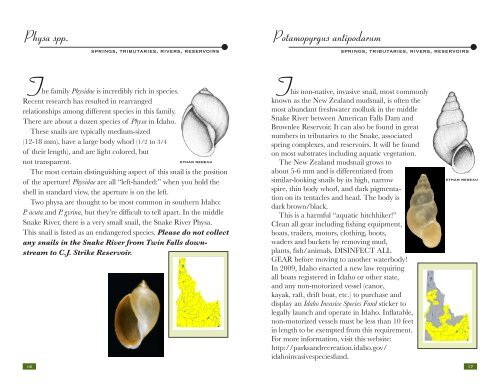Freshwater Mollusks - U.S. Fish and Wildlife Service
Freshwater Mollusks - U.S. Fish and Wildlife Service
Freshwater Mollusks - U.S. Fish and Wildlife Service
You also want an ePaper? Increase the reach of your titles
YUMPU automatically turns print PDFs into web optimized ePapers that Google loves.
Physa spp.<br />
T<br />
springs, tributaries, rivers, reservoirs<br />
he family Physidae is incredibly rich in species.<br />
Recent research has resulted in rearranged<br />
relationships among different species in this family.<br />
There are about a dozen species of Physa in Idaho.<br />
These snails are typically medium-sized<br />
(12-18 mm), have a large body whorl (1/2 to 3/4<br />
of their length), <strong>and</strong> are light colored, but<br />
not transparent.<br />
ethan nedeau<br />
The most certain distinguishing aspect of this snail is the position<br />
of the aperture! Physidae are all “left-h<strong>and</strong>ed:” when you hold the<br />
shell in st<strong>and</strong>ard view, the aperture is on the left.<br />
Two physa are thought to be most common in southern Idaho:<br />
P. acuta <strong>and</strong> P. gyrina, but they’re difficult to tell apart. In the middle<br />
Snake River, there is a very small snail, the Snake River Physa.<br />
This snail is listed as an endangered species. Please do not collect<br />
any snails in the Snake River from Twin Falls downstream<br />
to C.J. Strike Reservoir.<br />
Potamopyrgus antipodarum<br />
springs, tributaries, rivers, reservoirs<br />
T his non-native, invasive snail, most commonly<br />
known as the New Zeal<strong>and</strong> mudsnail, is often the<br />
most abundant freshwater mollusk in the middle<br />
Snake River between American Falls Dam <strong>and</strong><br />
Brownlee Reservoir. It can also be found in great<br />
numbers in tributaries to the Snake, associated<br />
spring complexes, <strong>and</strong> reservoirs. It will be found<br />
on most substrates including aquatic vegetation.<br />
The New Zeal<strong>and</strong> mudsnail grows to<br />
about 5-6 mm <strong>and</strong> is differentiated from<br />
similar-looking snails by its high, narrow<br />
spire, thin body whorl, <strong>and</strong> dark pigmentation<br />
on its tentacles <strong>and</strong> head. The body is<br />
dark brown/black.<br />
This is a harmful “aquatic hitchhiker!”<br />
Clean all gear including fishing equipment,<br />
boats, trailers, motors, clothing, boots,<br />
waders <strong>and</strong> buckets by removing mud,<br />
plants, fish/animals. DISINFECT ALL<br />
GEAR before moving to another waterbody!<br />
In 2009, Idaho enacted a new law requiring<br />
all boats registered in Idaho or other state,<br />
<strong>and</strong> any non-motorized vessel (canoe,<br />
kayak, raft, drift boat, etc.) to purchase <strong>and</strong><br />
display an Idaho Invasive Species Fund sticker to<br />
legally launch <strong>and</strong> operate in Idaho. Inflatable,<br />
non-motorized vessels must be less than 10 feet<br />
in length to be exempted from this requirement.<br />
For more information, visit this website:<br />
http://parks<strong>and</strong>recreation.idaho.gov/<br />
idahoinvasivespeciesfund.<br />
ethan nedeau<br />
16 17

















